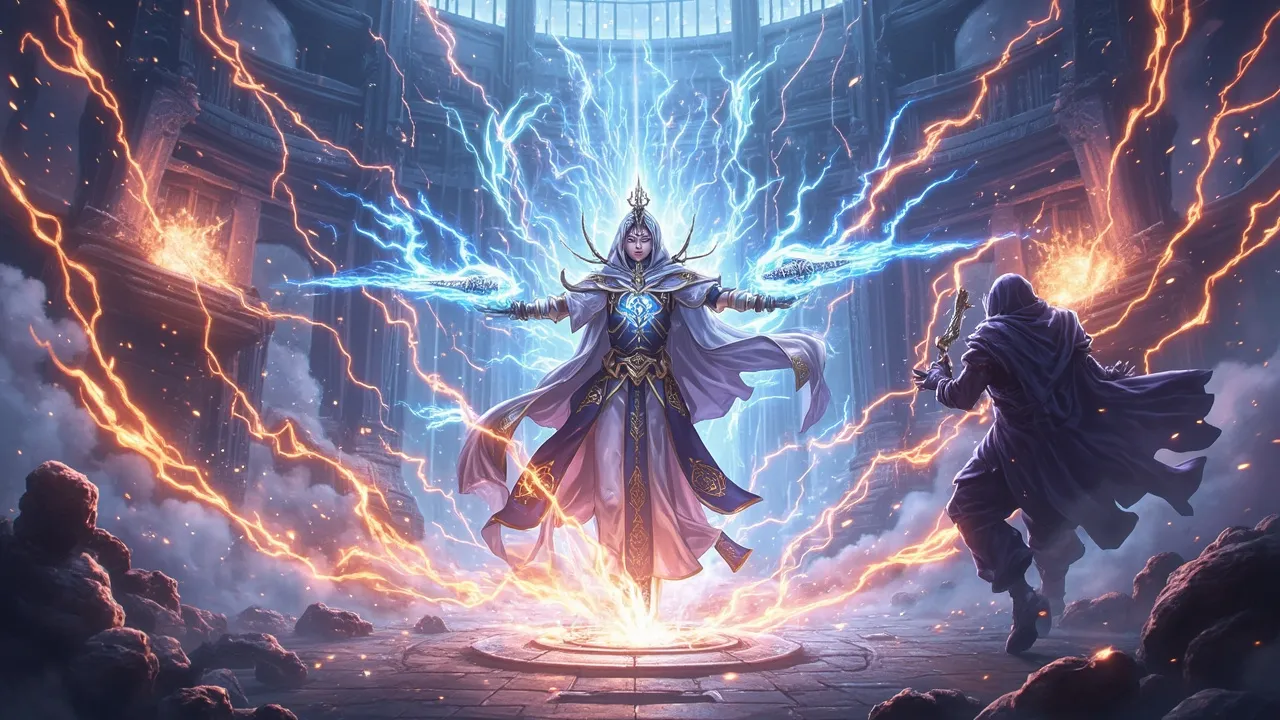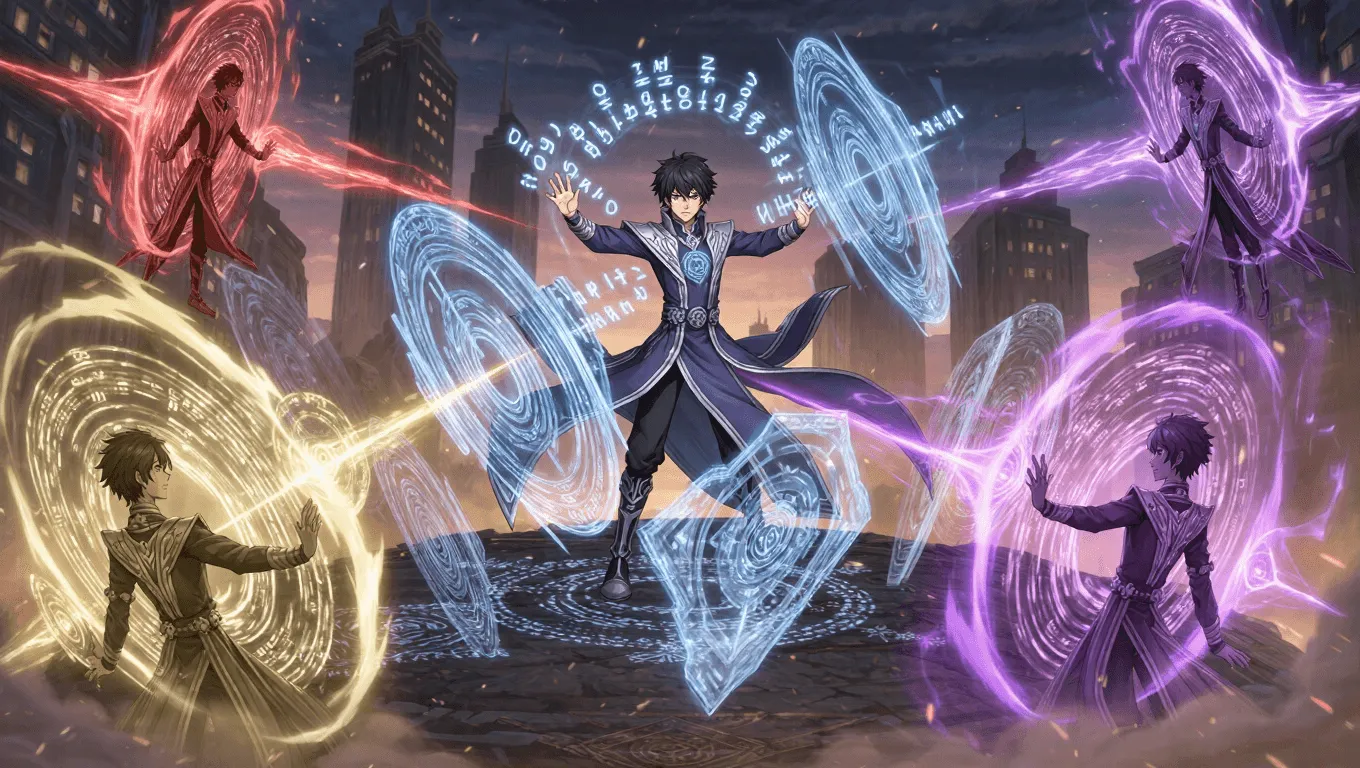Sorcerer’s Gambit

Sorcerer’s Gambit Video Demo 🎬
Table of Contents
- Sorcerer’s Gambit Video Demo 🎬
- What Is Sorcerer’s Gambit
- Core Abilities of Sorcerer’s Gambit
- Application / Tactical Advantages in Combat
- Level: Level 1 🏙️, Level 2 🌇, Level 3 🌃
- Limitations of Using the Sorcerer’s Gambit
- Weakness Against What Other Superpowers
- Synergistic Power Combos
- Known Users
- Practical Examples and Play Patterns
- Training and Mastery Tips
- Ethics and Worldbuilding Hooks
- Frequently Confused With
Sorcerer’s Gambit is a strategic magic superpower where the user manipulates outcomes by staking magical resources—mana, sigils, or fate itself—on calculated risks. In the first moments of a confrontation, the wielder chooses an arcane play: amplify a spell’s power, bend probability, or set a delayed enchantment that triggers later. This superpower blends spellcraft with game theory, turning every duel into a high-stakes match of arcane strategy. For readers exploring related abilities, see the full list of superpowers or spin the random superpower generator to discover new ideas.
What Is Sorcerer’s Gambit
Sorcerer’s Gambit is the art of shaping battles through tactical wagers. Each “gambit” is a spell-anchored decision that trades immediate certainty for potential advantage: extra damage now at the cost of vulnerability, a ward that strengthens later but leaves a brief opening, or a risky probability manipulation that can flip the board. Unlike raw magic manipulation, this power rewards foresight, runic calculus, and timing. It draws on elements of chaos magic, fate weaving, and probability manipulation, but frames them as moves in an evolving contest.
In essence, the user is a battlefield chessmaster. They read an opponent’s rhythm, place hexcraft “bets” into reality, then cash them out via counterspell beats, entropy control, or ritual casting at the perfect moment. Success depends on risk assessment, spell economy, and the nerve to push when odds tilt in their favor.
Core Abilities of Sorcerer’s Gambit
Arcane Risk-Rewards
Sorcerer’s Gambit lets the user stake mana or future certainty to boost present effects. Spend now, hit harder; save now, gain a stronger payoff later. This resembles pact magic and delayed-choice enchantments.
Probability Edging
The user nudges micro-probabilities—misfires, weapon jams, footing slips—without fully dictating fate. Think quick “luck edges” rather than absolute fate rewriting. It’s a scalpel, not a hammer.
Layered Spellcraft
Gambits stack. A mirror image gambit might be tied to a counterspell trap and a time-delayed teleportation seal. The more layers, the richer the payoff—if the caster can keep all plates spinning.
Tactical Foresight
Divination sparks—brief visions, trendlines of likely outcomes—inform which gambit to choose. The user sees possible branches and commits to the one with the highest expected value.
Eldritch Wards and Triggers
Wards can be primed with “if-then” logic: if an enemy casts an area spell, then the ward converts incoming force into a mana dividend; if a projectile hits, then it splinters into harmless illusions.
Counterplay Memory
Each exchange teaches the caster. Grimoires and talismans store “learning runes,” raising success rates for repeated gambits against the same opponent or tactic.
Resource Sculpting
Mana burn, mana banking, and siphoning are tactically managed. The user rebalances reserves across offense, defense, and control to keep an edge through long encounters.
Application / Tactical Advantages in Combat
Opening Theory: Establishing Tempo
A Gambit caster seizes tempo by planting fast, low-cost gambits that test reactions: feint illusions to force a premature shield; soft hexes that tilt footing; a minor fate nudge to misalign a sniper’s scope. The goal is information and initiative.
Midgame Control: Forcing Exchanges
Once patterns emerge, the caster engineers trades. A counterspell gambit punishes predictable spell timings. A battlefield control gambit reorders terrain via shifting sigils, funneling enemies into unfavorable lanes. Summoning and enchantment gambits bait out enemy ultimates.
Endgame Conversion: Cashing Out
When opponents are overextended, stored gambits pay off. Banked wards blossom into full barriers; a delayed entropy burst collapses enemy buffs; a time dilation slipstream allows a finishing combo. The win is not a single blast but a cascade of triggered advantages.
Dueling and Team Fights
In a duel, Sorcerer’s Gambit excels at “read-and-raise”: observe, counter, escalate. In squads, it amplifies allies through synchronized triggers—healers receive mana rebates on clutch saves; brawlers get brief invulnerability windows tied to their charge timings.
Level: Level 1 🏙️, Level 2 🌇, Level 3 🌃
Level 1 🏙️ — Apprentice of Odds

At this stage, the user wields minor probability edging, simple wards, and one active gambit at a time. Typical plays include:
-
Small hit-chance nudges and misdirection illusions
-
One-shot counterspell tags against basic projectiles
-
Mana banking with modest interest over short intervals
Limitations: low divination clarity, fragile wards, and noticeable casting tells. Still, a smart novice outplays brute-force foes by trading safely and forcing mistakes.
Level 2 🌇 — Architect of Exchanges

The caster can run multiple concurrent gambits with dependable divination pings and better spell economy. New tools include:
-
Conditional wards that convert blocked damage into mana or shields
-
Layered control: terrain channels, silence pockets, mirror-image recursion
-
Mid-combat ritual casting with accelerated sigils and runic calculus
Tactics now revolve around tempo traps and double-bluffs. The user wins not by raw power but by engineering favorable exchanges across several turns.
Level 3 🌃 — Grandmaster of the Board

At mastery, the user sees multi-branch futures and manipulates entropy across the entire arena. Signature capabilities:
-
Fate weaving at encounter scale: orchestrating sequences, not just moments
-
High-yield gambits that “cash out” into battlefield rewrites (weather veils, gravity tilts)
-
Counter-ultimates: reactive gambits that disassemble enemy finishers into resource windfalls
A Grandmaster can flip a lost fight with a single perfectly-timed cascade—an arcane gambit that turns enemy momentum into their downfall.
Limitations of Using the Sorcerer’s Gambit
-
Risk is real: High-return gambits expose openings. Misread the opponent, and the wager backfires.
-
Cognitive load: Tracking layers, timers, and triggers strains focus. Prolonged fights risk decision fatigue and misfires.
-
Resource volatility: Mana banking is vulnerable to drain, disruption, or mis-timed cash-outs. Overbidding can leave the user dry.
-
Counterplay visibility: Seasoned foes learn the caster’s rhythms. Repeated gambit patterns become predictable and punishable.
-
Line-of-sight and anchoring: Many wards require anchor points—sigils, talismans, or terrain marks subject to destruction.
-
Divination noise: Probability edges blur in chaotic environments (large crowds, overlapping powers), reducing forecasting accuracy.
-
Ethical and pact constraints: Some versions rely on pacts or chaos magic clauses that impose taboos, costs, or backlash on broken terms.
Weakness Against What Other Superpowers
-
Power Nullification / Anti-Magic Fields: Shut down anchors, cancel wards, and erase pending triggers.
-
Probability Lock or Fate Anchoring: Fixes outcomes, denying edges and collapsing gambit trees.
-
Technopathy / Gadgeteering: Detects and scrambles sigil circuits, deploys counter-runes via devices, or hard-jams ward frequencies.
-
Psionic Disruption: Attacks concentration, injects false divination signals, or induces casting hesitation.
-
Speedsters with Reaction Burst: Out-tempo the setup windows, striking before gambits mature.
-
Reality Anchors / Dimensional Stabilizers: Reduce entropy manipulation and limit space-bending plays like teleport triggers.
-
Pure Durability / Damage Soak: Tanky foes can ignore small edges long enough to outlast the payoff curve.
Synergistic Power Combos
-
Chronokinesis: Time dilation refines divination windows, stretches ward timers, and allows safe mid-battle rituals.
-
Luck Manipulation: Stacks cleanly with probability edging, converting small nudges into decisive swings.
-
Barrier Generation: Stabilizes the setup phase, buying time for layered gambits to mature.
-
Summoning / Construct Magic: Provides mobile anchors for wards and conditional triggers tied to ally actions.
-
Telepathy (Light-Touch): Shares tactical foresight with teammates without overloading the caster’s bandwidth.
-
Illusion Mastery: Feeds misinformation loops that bait enemies into counterspell traps or resource-wasting responses.
-
Spatial Manipulation: Enhances funneling terrain, pinch points, and forced rotations for battlefield control.
Known Users
-
Doctor Stephen Strange — A canonical example of strategic spellcraft and layered wards in popular media. See his character profile on Marvel.com.
-
Zatanna Zatara — Known for conditional spellcasting and performance-timed magic patterns. Explore her bio on DC.com.
-
The Gambit Theorists — An in-universe cabal of arcane analysts who codified runic calculus and spell economy for competitive magical dueling. Their practices emphasize grimoires that record encounter data to refine future gambits.
-
The House of Mirrors — A clandestine troupe of illusionists who weaponize mirror-image recursion and counterspell beats to choreograph endgame cascades in citywide conflicts.
Practical Examples and Play Patterns
The Safe Edge
Open with a low-risk probability nudge on enemy accuracy while banking a sliver of mana. Follow with a minor ward that refunds resources if struck. If the enemy pressures, the user cashes out the bank to reinforce; if they misfire, the user pivots to offense.
The Double Bluff
Plant a visible sigil to lure a premature nullification. The true gambit sits off-axis—an invisible trigger tied to sound or motion. When the opponent commits to the decoy, the hidden counterspell converts their ultimate into a mana dividend and a brief vulnerability window.
The Endgame Cascade
After three measured trades, stored wards convert into a terrain shift, tightening lanes. A time slipstream opens, allies charge through, and a fate weave triggers at the moment of overlap—disabling enemy buffs and magnifying ally crit windows for a decisive finish.
Training and Mastery Tips
-
Runic Journaling: Track gambit outcomes, not just wins. Identify overbids, late cash-outs, and misreads to tune risk appetite.
-
Casting Hygiene: Minimize tells—hand patterns, breath cadence, and sigil glow signatures. Variability protects against counter-readers.
-
Resource Drills: Practice fighting with capped mana to sharpen decision quality under scarcity.
-
Noise Calibration: Simulate “divination static” with unpredictable stimuli to maintain clarity in chaotic arenas.
-
Team Sync: Pre-plan triggers with allies: tie shields to heal thresholds, counters to enemy cast ticks, and teleports to friendly ult rotations.
Ethics and Worldbuilding Hooks
-
Gambit Debt: Some settings treat failed gambits as cosmic debts—until repaid, divination clarity is taxed.
-
Probabilistic Taboos: Cultures might outlaw certain edges as unfair “fate doping.”
-
Arcane Markets: Black-market talismans sell gambit insurance—tokens that absorb backfire, at a cost.
-
Tournament Metas: Competitive magical dueling evolves “metas” favoring fast edges one season, slow banks the next, driven by countermeasure tech.
Frequently Confused With
-
Luck Manipulation: Pure luck control overrides odds; Sorcerer’s Gambit hedges them via calculated trades.
-
Standard Spellcasting: Traditional spellcraft fires-and-forgets; gambits embed conditional logic and resource wagers.
-
Precognition: True foresight sees fixed futures; gambit divination samples branches to inform choices, not dictate them.
By framing magic as calculated plays—each with its own costs, counters, and cash-out moments—Sorcerer’s Gambit transforms combat into a contest of nerve and numbers. In the right hands, a single gambit can become the thread that unravels an entire enemy strategy. For more powers that pair well with this style, browse the superpower wiki or discover a random ability with our generator.
